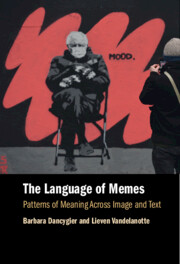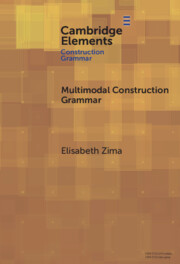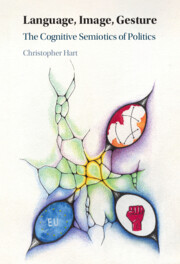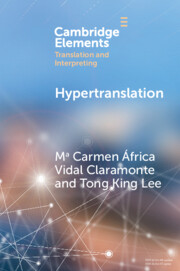Refine search
Actions for selected content:
94 results
4 - Digital Interaction in the History of English
- from Part I - The Transmission of English
-
-
- Book:
- The New Cambridge History of the English Language
- Published online:
- 23 October 2025
- Print publication:
- 23 October 2025, pp 107-136
-
- Chapter
- Export citation

The Language of Memes
- Patterns of Meaning Across Image and Text
-
- Published online:
- 12 September 2025
- Print publication:
- 11 September 2025
2 - Memes and Multimodal Figuration
-
- Book:
- The Language of Memes
- Published online:
- 12 September 2025
- Print publication:
- 11 September 2025, pp 11-25
-
- Chapter
- Export citation
1 - Why Study Memes from the Linguistic Perspective?
-
- Book:
- The Language of Memes
- Published online:
- 12 September 2025
- Print publication:
- 11 September 2025, pp 1-10
-
- Chapter
- Export citation

Multimodal Construction Grammar
-
- Published online:
- 25 August 2025
- Print publication:
- 25 September 2025
-
- Element
- Export citation
5 - Blended Learning
- from Part II - Environments
-
-
- Book:
- The Cambridge Handbook of Technology in Language Teaching and Learning
- Published online:
- 15 June 2025
- Print publication:
- 26 June 2025, pp 75-89
-
- Chapter
- Export citation
2 - Literacy in Postdigital Times
-
- Book:
- The Comfort of Screens
- Published online:
- 10 April 2025
- Print publication:
- 17 April 2025, pp 26-45
-
- Chapter
- Export citation
3 - People on Screens
-
- Book:
- The Comfort of Screens
- Published online:
- 10 April 2025
- Print publication:
- 17 April 2025, pp 46-69
-
- Chapter
- Export citation
Integrating collaborative digital multimodal tasks in Spanish as a second language course
-
- Article
-
- You have access
- Open access
- HTML
- Export citation
1 - Introduction
-
- Book:
- Language, Image, Gesture
- Published online:
- 08 January 2025
- Print publication:
- 13 February 2025, pp 1-27
-
- Chapter
- Export citation
13 - Critical Linguistic Awareness
- from Part IV - Activism in the Public Space
-
-
- Book:
- Language Activism
- Published online:
- 31 May 2025
- Print publication:
- 06 February 2025, pp 181-192
-
- Chapter
- Export citation
Chapter 40 - Multimodality in Strategy-as-Practice Research
- from Part V - Substantive Topic Areas
-
-
- Book:
- Cambridge Handbook of Strategy as Practice
- Published online:
- 11 March 2025
- Print publication:
- 23 January 2025, pp 729-739
-
- Chapter
- Export citation

Language, Image, Gesture
- The Cognitive Semiotics of Politics
-
- Published online:
- 08 January 2025
- Print publication:
- 13 February 2025
1 - What Is Talk and Why Do Children Need It?
-
- Book:
- Children's Online Language and Interaction
- Published online:
- 19 December 2024
- Print publication:
- 02 January 2025, pp 1-26
-
- Chapter
- Export citation
34 - Opening Up Avenues into Action: Future Directions in Conversation Analysis
- from Part VII - Looking Forward
-
-
- Book:
- The Cambridge Handbook of Methods in Conversation Analysis
- Published online:
- 06 December 2024
- Print publication:
- 05 December 2024, pp 943-973
-
- Chapter
- Export citation
25 - Multimodality in Conversation Analysis
- from Part V - Avenues into Action
-
-
- Book:
- The Cambridge Handbook of Methods in Conversation Analysis
- Published online:
- 06 December 2024
- Print publication:
- 05 December 2024, pp 700-742
-
- Chapter
- Export citation
12 - Developing a Collection: Coordination of Embodied Conduct with Darf/Kann ich X? ‘May/Can I …?’ in German
- from Part III - Collections
-
-
- Book:
- The Cambridge Handbook of Methods in Conversation Analysis
- Published online:
- 06 December 2024
- Print publication:
- 05 December 2024, pp 276-312
-
- Chapter
- Export citation
3 - Collecting Interaction Data in the ‘Lab’ versus the ‘Field’: Rationale, Ramifications, and Recommendations
- from Part II - Points of Departure
-
-
- Book:
- The Cambridge Handbook of Methods in Conversation Analysis
- Published online:
- 06 December 2024
- Print publication:
- 05 December 2024, pp 81-96
-
- Chapter
- Export citation

Hypertranslation
-
- Published online:
- 29 November 2024
- Print publication:
- 16 January 2025
-
- Element
- Export citation
Chapter 6 - Editions
-
-
- Book:
- The Cambridge Companion to Literature in a Digital Age
- Published online:
- 29 November 2024
- Print publication:
- 14 November 2024, pp 107-124
-
- Chapter
- Export citation
